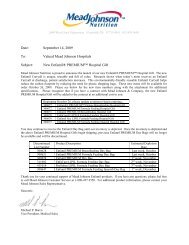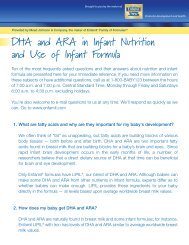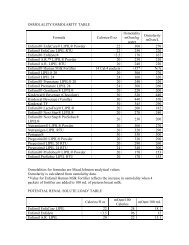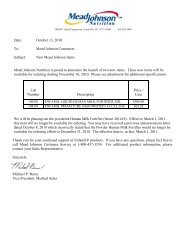LB2882MaternalNutriti+ - Mead Johnson Nutrition
LB2882MaternalNutriti+ - Mead Johnson Nutrition
LB2882MaternalNutriti+ - Mead Johnson Nutrition
You also want an ePaper? Increase the reach of your titles
YUMPU automatically turns print PDFs into web optimized ePapers that Google loves.
the recommendations, summarized below, are related to micronutrient intakes and/or supplementation. In general,<br />
the group that developed the guidelines agreed that “healthy dietary practices should be promoted in the general<br />
population, including among pregnant women.” 39<br />
The WHO guidelines recommend calcium supplementation for pregnant women residing in areas where dietary<br />
calcium intake is low. The recommendation states, “ In areas where dietary calcium intake is low, calcium<br />
supplementation during pregnancy (at doses of 1.5-2.0 g elemental calcium/day) is recommended for the prevention<br />
of pre-eclampsia in all women, but especially in those at high risk of developing pre-eclampsia.” Additional<br />
calcium supplementation, however, does not improve outcomes related to pre-eclampsia and pregnancy- related<br />
hypertensive disorders for populations with adequate calcium intake. 39<br />
The expert group agreed that avoiding excessive dietary salt intake is a healthy dietary practice. However, restricting<br />
dietary salt intake during pregnancy to prevent pre-eclampsia was not recommended. The group did not define<br />
“excessive salt intake.” (Sodium intake recommendations during pregnancy are provided in Table 9). In addition,<br />
supplementation with vitamin D and supplementation with the antioxidant vitamins C and E, individually or in<br />
combination, are not recommended to prevent pre-eclampsia and its complications since research data available at<br />
the time did not support a beneficial effect. 39<br />
Gestational Diabetes<br />
Gestational diabetes mellitus (GDM) affects about 4% of all pregnancies worldwide. 141 Risk factors for GDM include<br />
having an immediate family member with diabetes, being overweight, having pre-diabetes, or having a history of<br />
GDM in a past pregnancy. Women with GDM have an increased risk of developing hypertension during pregnancy<br />
and are more likely to have a cesarean delivery, as infants born to mothers with poorly controlled GDM may be larger<br />
at birth, and macrosomic neonates are more prone to birth injury. 142 Children born to mothers with poorly controlled<br />
GDM are at greater risk for breathing problems and other serious illnesses in the newborn period, and they are more<br />
likely to become overweight in childhood or as adults. All pregnant women should be screened for GDM risk at their<br />
first prenatal visit. 40<br />
Women with GDM should receive nutritional counseling about a balanced diet that meets pregnancy nutrition needs,<br />
promotes appropriate weight gain, and fosters blood glucose control. 40 Appropriate weight gain may lessen risk of<br />
undesirable pregnancy outcomes. For example, women with singleton pregnancies diagnosed with GDM who gained<br />
more than the suggested amounts during pregnancy had higher risk of preterm delivery, delivering macrosomic<br />
neonates, and cesarean delivery. 143 In obese women with GDM, moderate caloric restriction may improve glycemic<br />
control without inducing ketonuria. 123 Women should also be made aware of the glucose-lowering benefits of physical<br />
activity. Programs of moderate physical exercise have been shown to lower maternal glucose concentrations in<br />
women with GDM and those without medical or obstetrical contraindications should be encouraged to start or<br />
continue a program of moderate exercise as a part of treatment for GDM. 144<br />
Women with GDM should be aware that they have a much higher risk (about 7 times higher) for developing type 2<br />
diabetes after delivery than women without GDM. 145 Therefore, in the US, the National Diabetes Education Program<br />
recommends that women with GDM be screened for type 2 diabetes 6 to 12 weeks after delivery. If initial blood<br />
glucose concentrations are normal, these women should be screened for type 2 diabetes every 3 years. 145 Women<br />
who had GDM can help lower their risk for developing type 2 diabetes by losing weight, increasing physical activity<br />
and making healthy food choices. Children born to women with GDM are also more likely to become obese and<br />
develop type 2 diabetes. Children’s risk is also lower if they stay at a healthy weight, consume a healthy diet and<br />
incorporate daily physical activity. 145<br />
27

















